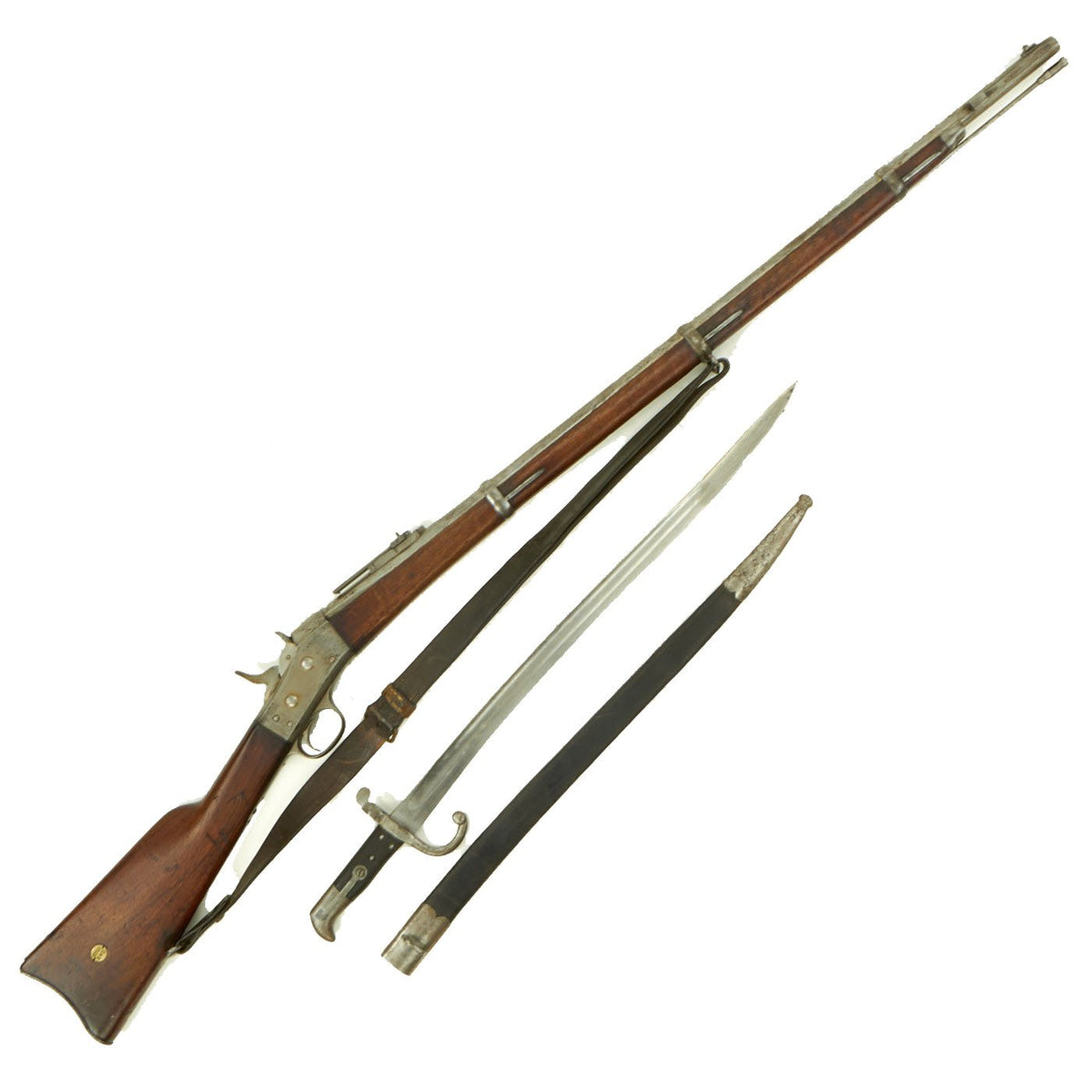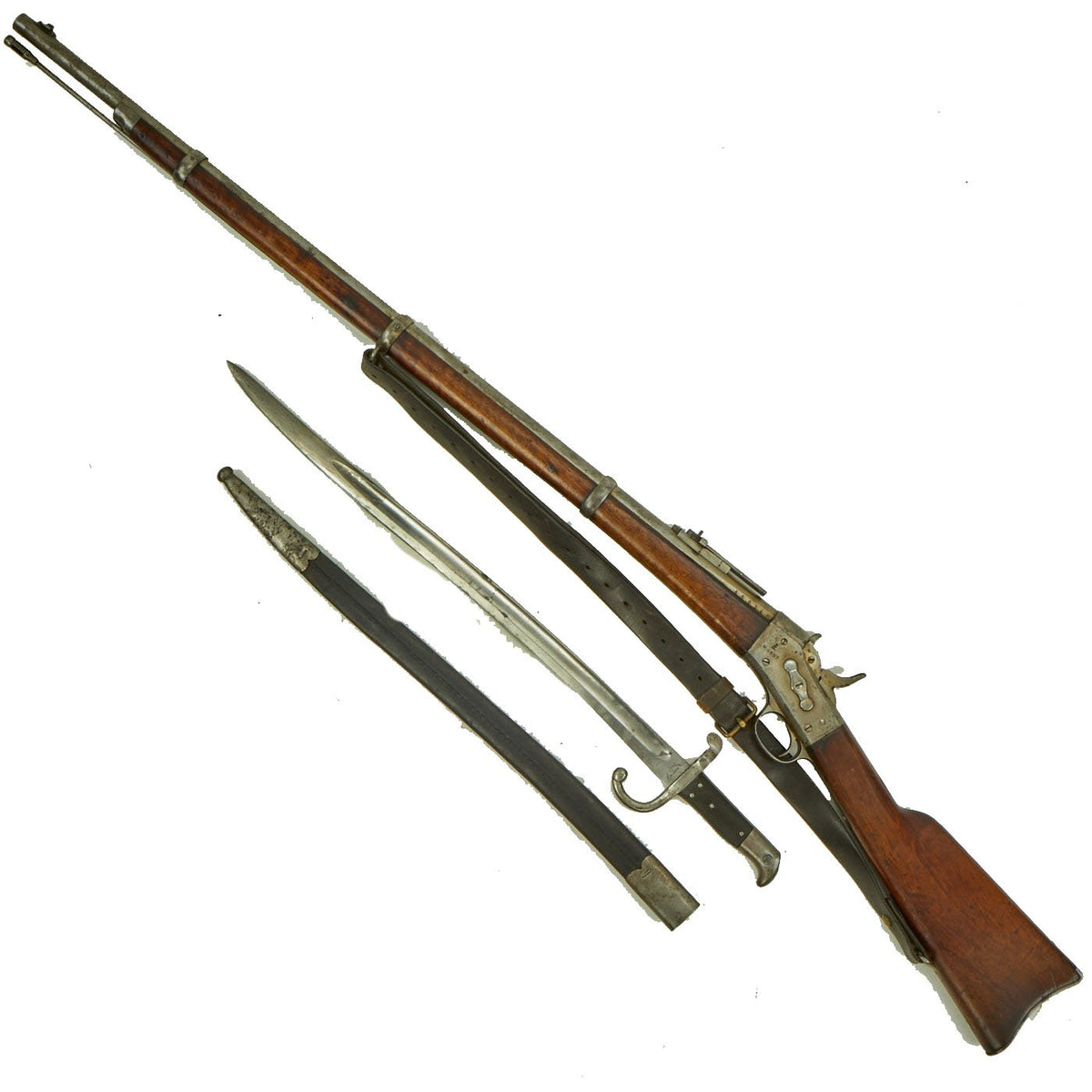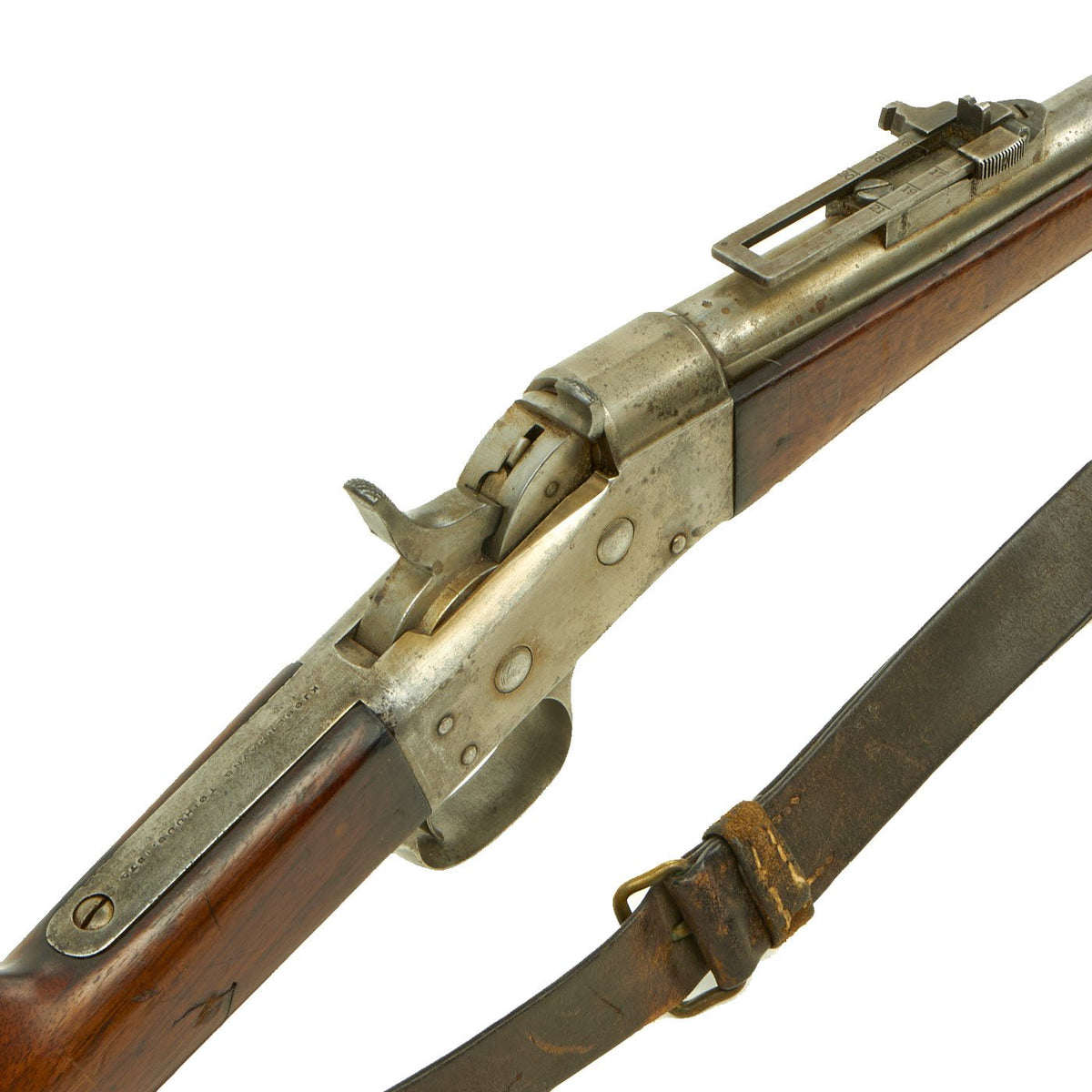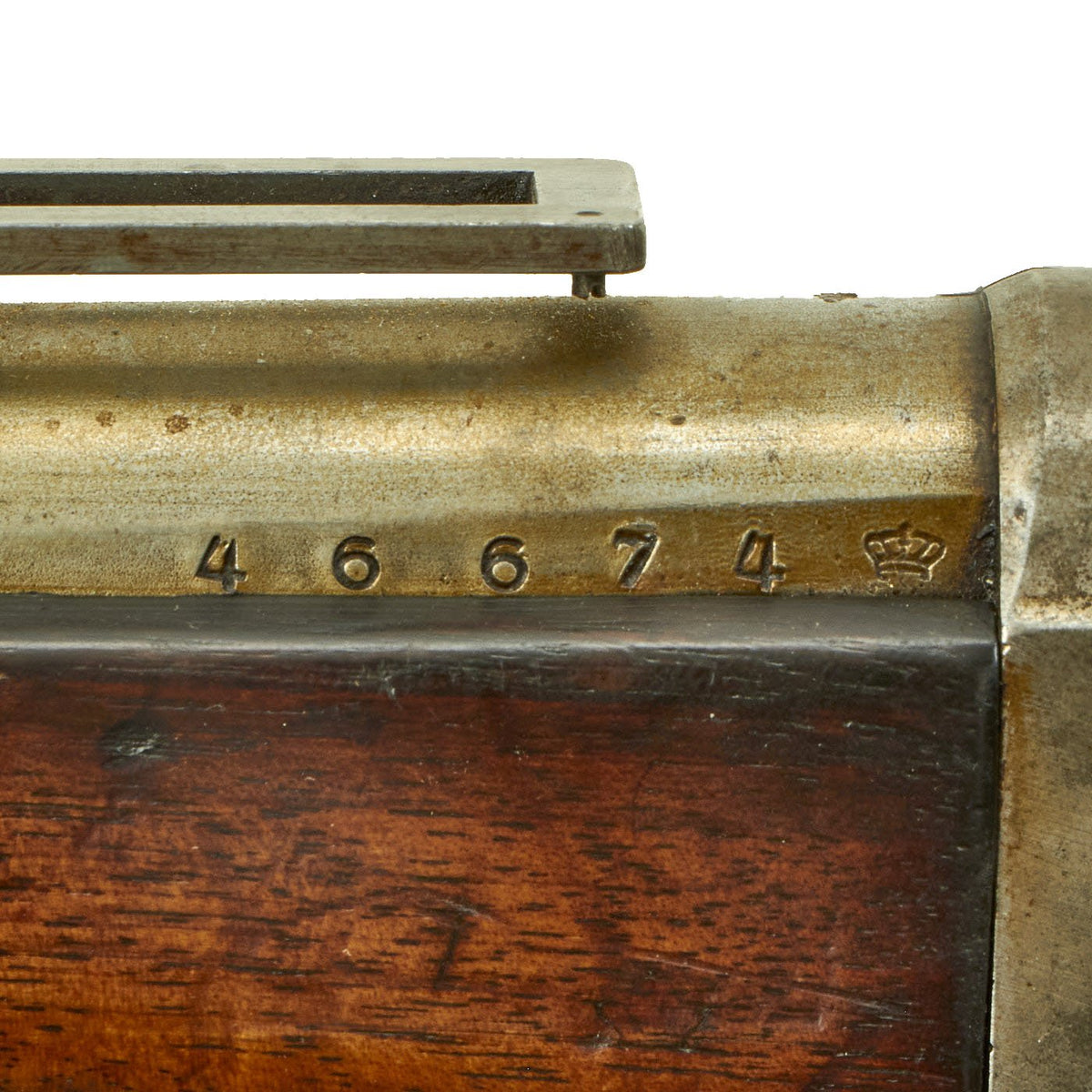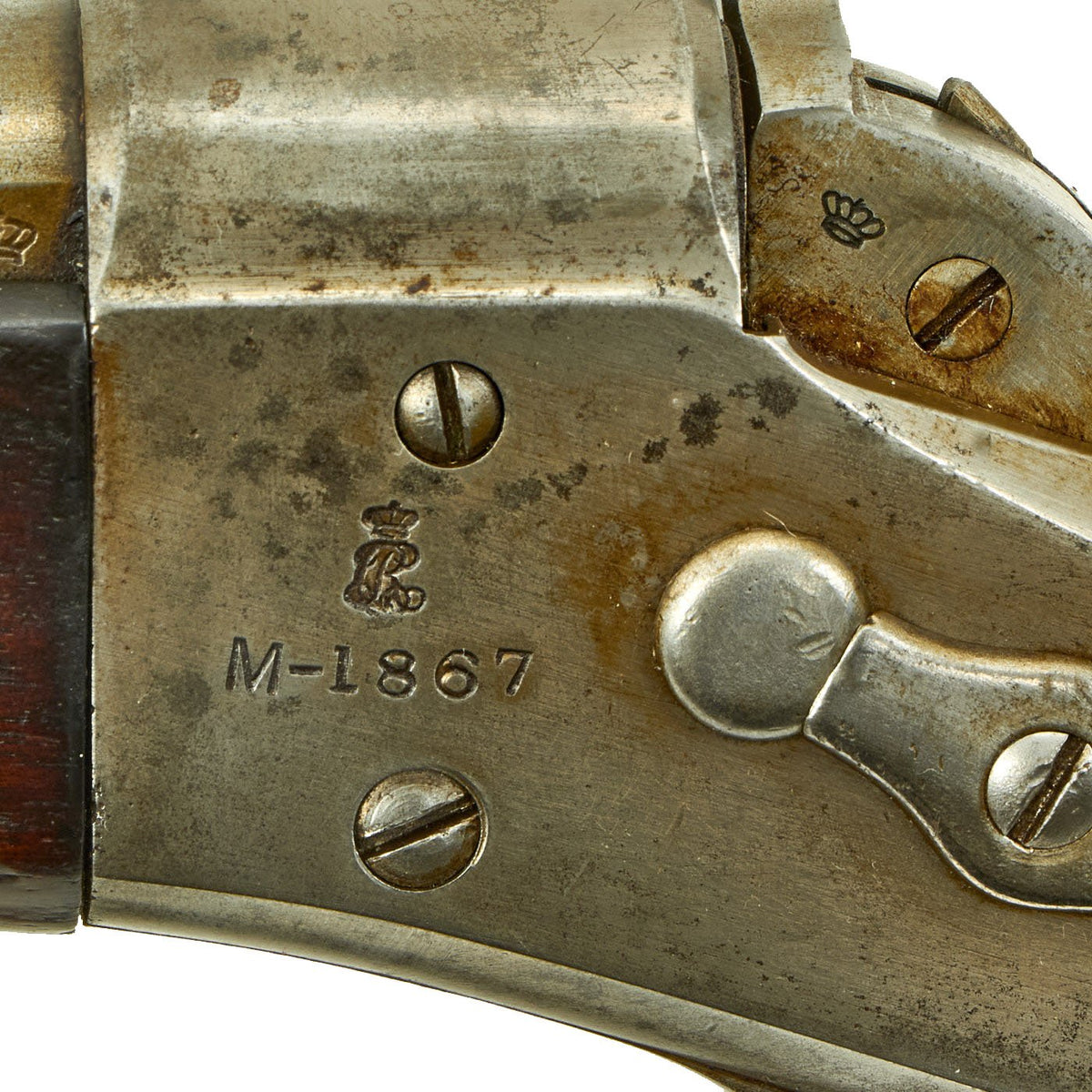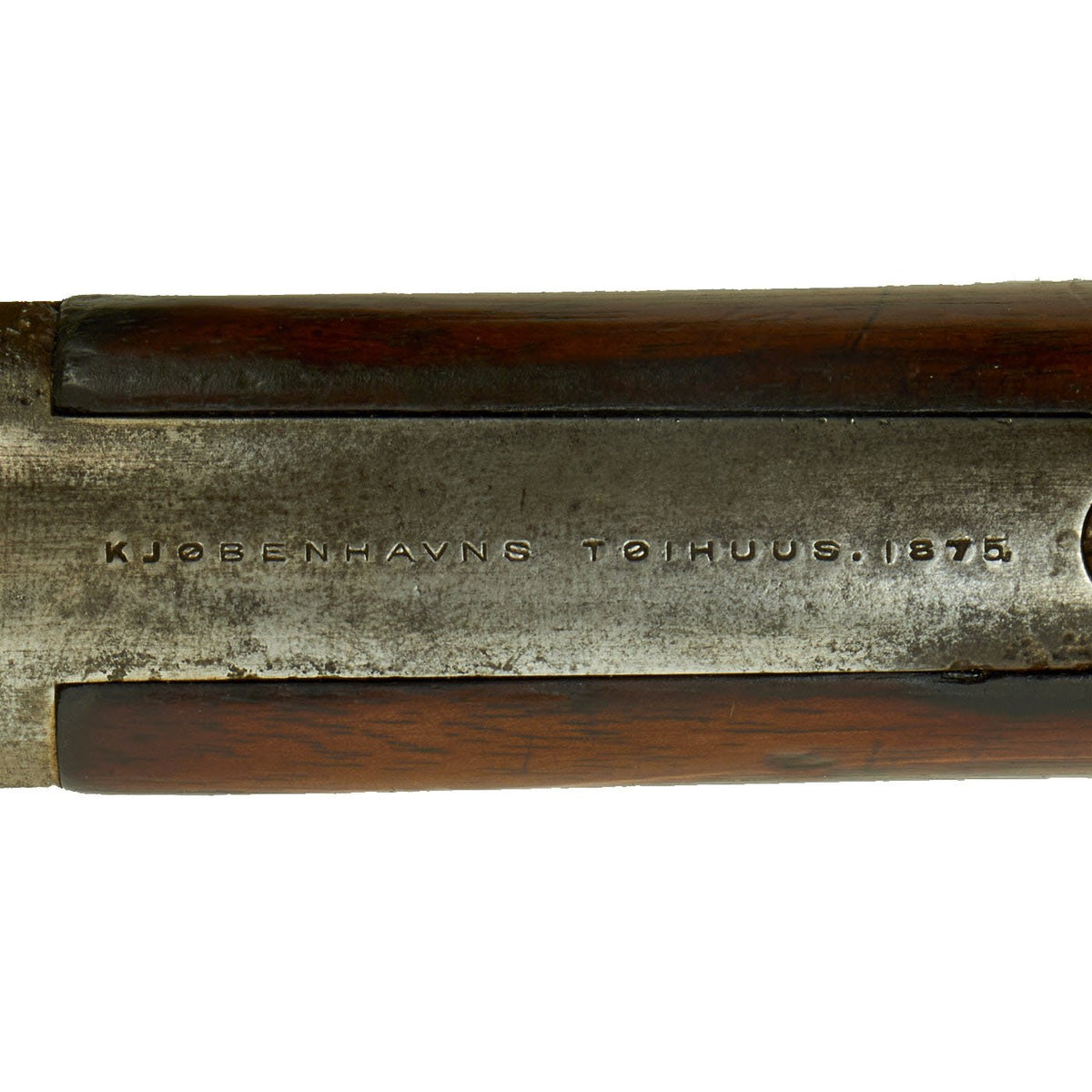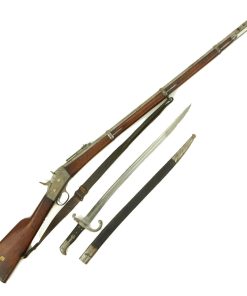Original Danish M1867/96 Remington Rolling Block Rifle dated 1875 with Saber Bayonet & Sling – Serial 46674 Original Items
$ 1.595,00 $ 398,75
Original Item: Only One Available. The Danes elected to license the Remington design for manufacture in Denmark at the Copenhagen arsenal, which they did in a fairly large quantity. The Danish model first utilized a rimfire cartridge and that stayed in service well into the smokeless era. However, with the adoption of the 8mm M1889 Krag-Jorgensen the need to update or abandon the Remington became acute. In 1896 they were withdrawn from infantry service, converted to centerfire cartridge and issued to coast and fortress artillerymen. At that time a new much longer rear ladder sight was also fitted to the rifles.
After World War II a large quantity were sold surplus back to the US where these type first entered civilian hands, being misleadingly sold in large quantity as .45-70 Rolling blocks!
This rifle features a 3.25″ long backsight leaf. Left receiver flat is stamped with a Crown over the Danish Royal Cypher over the mark M-1867. The right receiver wall is bare and the upper tang is marked KJØBENHAVNS TOIHUUS 1882 (Copenhagen Arsenal) with serial number 46674 on the barrel and on the underside of the butt stock. The rifle bears the Danish Crown on the barrel, barrel bands, rear and front stock, and other components. There is also a rear stock disk, which is marked 2AB / 1528, for the 2nd Artillery Battalion, 1528th weapon.
Condition of the rifle is very good, showing a nice patina of age typical of a well cared-for rifle. The originally bright steel has faded a bit to a grayish patina in areas, with just a bit of rust peppering in areas. The wood does show wear and the expected denting from service, but no repairs that we can see. The stocks match in color, most likely made from beech wood, and the fore stock has some great curl to the grain. The bore is excellent, with a bright finish and very clear lands and grooves. This rifle was fired very little, if at all, so most of the wear on the exterior is just from age and handling.
This particular rifle comes complete with the correct issue bayonet, a Yataghan-style saber bayonet of German manufacture. The ricasso of the blade is marked with GEBR. WEYERSBERG / SOLINGEN, for Gebrüder Weyersberg, Waffenfabrik, which from 1859 onward operated a factory on Hochstrasse in the Ohligs area of the City of Solingen. Called “The City of Blades”, Solingen is a world-renowned edged weapon area, with a history dating back to the middle ages. The Weyersberg family itself had a history of swordmaking going back at least 6 generations. The company had numerous contacts and customers in Europe, and supplied weapons to Napoleon’s army, as well as to the Prussian and Russian armies during the 19th century.
The sudden death of Hermann Weyersberg in 1883 caused a management issue, and the manufacturing portion of the company was amalgamated with W.R. Kirschbaum to form the well-known firm of Weyersberg, Kirschbaum & Co.. For more information please see J. Anthony Carter’s work GERMAN KNIFE AND SWORD MAKERS.
This bayonet also has a leaf spring catch, and not a coil spring, indicating production prior to 1884. With the Danish Crown on the pommel, this is definitely the correct type of bayonet for this rifle. The leather of the grips still shows the original checkering, with only light wear, and no tearing or shrinking. The blade is in excellent condition, while the fittings on the scabbard and hilt have a bit of oxidation. The leather of the scabbard is still supple. It mounts securely to the rifle, with no locking issues.
Centerfire converted rifles chamber a cartridge near to the US Govt. .45-70, the 11.7x51R, a bit shorter and a bit larger. A .45-70 will function but will expand at the base and may overcrimp at the neck, not safe conditions. The rimfire cartridge was somewhat shorter but usable in the converted rifles. In fact, after conversion, the rifle could fire either rimfire or centerfire ammunition.
The Danish model first utilized a rimfire cartridge which stayed in service well into the smokeless era. This created a potential compatibility problem, rimfire cartridges won’t fire in a central fire rifle, and center-fire cartridges won’t operate in a rimfire rifle. However, if you look carefully, you will see that the breech block of the Danish Remington Rolling Block has two firing pin holes, one for center fire and one at the bottom of the breech block face for rimfire. The firing pin is fairly easily reversible, for use of the rifle with whatever (rimfire or central fire) ammunition is available.
The first 30,000 Danish Rolling Blocks were Danish built on Remington made actions. Thereafter they were constructed under license in Copenhagen, Denmark.
A fine rifle worthy of any Remington or Scandinavian collection.
Specifications (Rifle)-
Year of Manufacture: 1882
Caliber: 11×41.5mmRF or 11.7x51R
Cartridge Type: Rimfire Cartridge or Centerfire
Barrel Length: 35 Inches
Overall Length: 50.5 Inches
Action type: Rolling Breechblock External Hammer
Feed System: Single Shot
Specifications (Bayonet)-
Overall length: 27 ¼”
Blade length: 21 ¾”
Crossguard: 4 3/4 “
Scabbard length: 22 ¼”
NOTE: International orders of antique firearms MUST be shipped using UPS WW Services (courier). USPS Priority Mail international will not accept these.
Fast Shipping with Professional Packaging
Thanks to our longstanding association with UPS FedEx DHL, and other major international carriers, we are able to provide a range of shipping options. Our warehouse staff is expertly trained and will wrap your products according to our exact and precise specifications. Prior to shipping, your goods will be thoroughly examined and securely secured. We ship to thousands clients each day across multiple countries. This shows how we're dedicated to be the largest retailer on the internet. Warehouses and distribution centres can be located throughout Europe as well as the USA.
Note: Orders with more than one item will be assigned a processing date depending on the item.
Before shipping before shipping, we'll conduct a thorough inspection of the items you have ordered. Today, the majority of orders will be delivered within 48 hours. The delivery time will be between 3-7 days.
Returns
The stock is dynamic and we cannot completely manage it because multiple stakeholders are involved, including our factory and warehouse. So the actual stock may alter at any time. It's possible that you may not receive your order once the order has been made.
Our policy is valid for a period of 30 days. If you don't receive the product within 30 days, we are not able to issue a refund or an exchange.
You can only return an item if it is unused and in the same state as the day you received it. You must have the item in its original packaging.
Related products
Uncategorized
Uncategorized
Uncategorized
Uncategorized
Uncategorized
Uncategorized
Band of Brothers ORIGINAL GERMAN WWII Le. F.H. 18 10.5cm ARTILLERY PIECE Original Items
Uncategorized
Angolan Rebel 1970s era 60mm Inert Display Mortar from Angolan Civil War Original Items
Uncategorized
Uncategorized
Australian WWII Owen MK1 Machine Carbine SMG Custom Fabricated Replica with Sling Original Items
Uncategorized
Uncategorized
Uncategorized
Uncategorized
Armored Burgonet Helmet & Polearm from Scottish Castle Leith Hall Circa 1700 Original Items
Uncategorized
Uncategorized
Uncategorized
Uncategorized
Uncategorized
